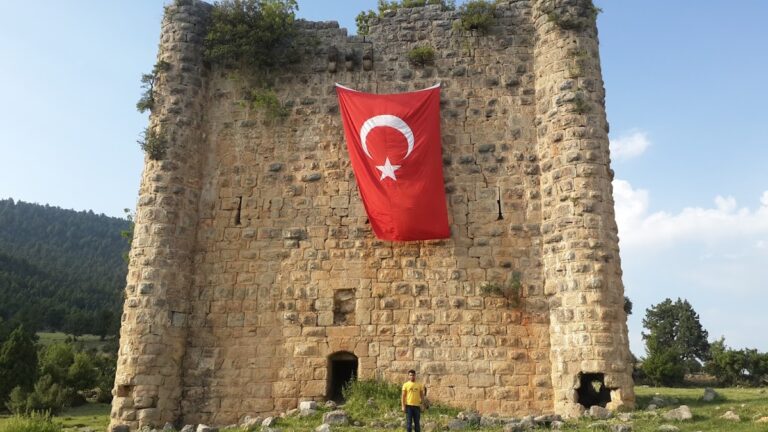Lampron Fortress: An 11th-Century Armenian Stronghold in Turkey
Visitor Information
Google Rating: 4.5
Popularity: Low
Google Maps: View on Google Maps
Official Website: www.castles.nl
Country: Turkey
Civilization: Armenian, Byzantine, Crusader, Medieval Islamic
Remains: Military
History
Lampron is a fortress built in the 11th century under Armenian hands, situated in the municipality of Çamlıyayla in what is now Turkey. Originally part of the Armenian Kingdom of Cilicia, the site holds a layered history shaped by diverse regional powers.
The fortress came under Armenian control in 1073 when Aplgharib Artsruni, a local governor appointed by the Byzantine Empire, granted it to Ōšin, an Armenian noble from Gandzak. This transfer followed Ōšin’s successful campaign to wrest the castle from Arab rule. The fortress became the hereditary seat of the Hetumid family, an important Armenian noble house that played a significant role in the history of Cilicia during the Crusader era. Lampron was thus both a military stronghold and a base for noble governance.
Throughout the latter half of the 12th century, Lampron witnessed several military confrontations, surviving sieges in 1171, 1176, and 1182. Eventually, in the early 1200s, the castle changed hands through a clever political move when King Levon I, founder of the Rubenid dynasty, secured control by arranging a marriage alliance that overcame the defenders’ resistance.
The 13th century brought further turmoil. In the 1240s, Lampron became the center of a rebellion against King Het’um I, led by Baron Constantine of Lampron. Seeking support from the Seljuk Sultan Kaykhusraw II, Constantine challenged royal authority but was ultimately defeated by the king’s forces under Constable Smbat. Constantine was captured and executed in 1250, ending the uprising.
Later, between 1309 and 1310, the fortress briefly served as a prison for King Henry II of Cyprus, who belonged to the Lusignan dynasty. In the centuries that followed, Lampron was occupied by Mamluk forces during the late 14th century and later passed into the hands of the Karamanid beylik and eventually the Ottoman Empire.
Over time, the fortress has been known by several names reflecting the shifting cultural influences: the Armenians called it Lampron, the French referred to it as Les Embruns, and the Turks named it Namrun Kalesi.
Remains
Perched on a limestone plateau stretching about 330 meters by 150 meters and perched atop a hill with steep drops exceeding 50 meters to the valley below, Lampron commands expansive views and dominion over adjacent mountain passes leading toward Tarsus and the Cilician Gates. The natural terrain shaped its defensive layout, dividing the fortress into two primary sections: a smaller, narrow lower bailey extending south and west, and an expansive upper bailey reached solely by climbing rock-cut stairs through a winding, narrow entrance path.
Within the upper bailey lie the ruins of many buildings whose foundations were carefully chiseled directly into the bedrock, demonstrating skilled stonework and adaptation to the rocky site. At the northern end, six vaulted chambers stand side-by-side, with two of these featuring battlements and narrow apertures designed for archers. These chambers are built using blocks of finely dressed limestone, revealing a high level of craftsmanship. Among the ruined structures, a vaulted hall remains intact, offering a glimpse into the castle’s medieval architectural sophistication.
Remarkably, portions of the upper bailey were equipped with hypocaust heating systems, an ancient method where hot air circulated beneath floors to warm rooms, indicating advanced medieval comfort technology. At the northwest tip, a dry moat was dug as an additional defense to separate the castle from the surrounding plateau, enhancing its isolation and defense.
The lower bailey contains a small medieval bathhouse located on the southwest side below its walls. This bath comprises five rooms aligned both east-west and north-south and also employed a hypocaust system for heating, underscoring the inhabitants’ concern for hygiene and warmth.
Finally, Lampron’s strategic positioning allowed it to maintain visual signals with Sinap Castle, about three kilometers to the northeast, facilitating coordination of defensive efforts across the region.
Taken together, the architectural remains at Lampron illustrate a fortress carefully molded to rugged terrain, with sophisticated defensive and domestic features that reflect its historical role as a noble stronghold in medieval Armenian Cilicia.






